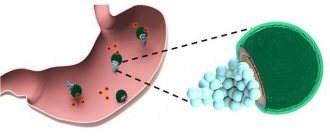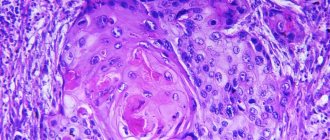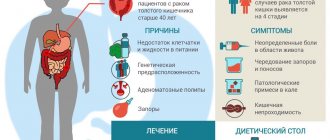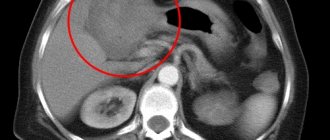Stage 4 colon cancer is the last stage of malignancy, ranking third among all oncologies. Unfortunately, the prognosis at this stage is unfavorable and treatment practically does not produce any results. Doctors try to keep the patient alive and reduce pain and unpleasant symptoms.
Signs and symptoms
Stage 4 colon cancer and its signs at the beginning of development:
- Fever.
- Loss of body weight.
- Apathetic state.
- The taste buds are distorted and all tastes are perceived differently.
- Loss of appetite.
In the middle or at the end of the disease:
- During defecation, discharge of the following nature can be observed: purulent, mucous, bloody, purulent-bloody, purulent-mucosal.
- Unpleasant feeling in the anus or rectum, sensation of a foreign body.
- Constipation, feeling of heaviness and pain in the rectum.
- Lower back pain.
- Pain, bloating in the abdomen.
- Pain in metastatic organs.
- A tumor may protrude on the abdomen.
- If the tumor has already penetrated the bladder, then during exertion, for example, defecation or physical activity, urine is released.
- During urination, women experience fecal discharge.
- Abdominal ascites - metastasis occurs in the abdomen, in the internal cavity.
The tumor can be localized in the intestine, but metastases spread throughout the body, and sometimes specific symptoms for this pathology are observed, such as:
- Yellowness of the mucous membranes, sclera, skin, with metastases to the liver.
- Difficulty breathing, hemoptysis, mucus with pus - with metastasis in the lungs.
- Migraines, dizziness, headaches - with a secondary tumor in the brain.
Symptoms of the disease
As colon cancer progresses, the organ wall becomes damaged and disintegrates. In this regard, the entire contents of the intestinal lumen penetrates the bloodstream and poisons the body. The clinical picture of intestinal cancer is nonspecific. The diagnosis can only be made in combination with symptoms and laboratory data. There are several groups of symptoms.
- Intoxication syndrome. It manifests itself as weakness, loss of appetite, nausea, headache and dizziness, persistent increase in body temperature to subfebrile levels (not higher than 37.5 degrees), joint pain, pallor of the skin, shortness of breath and tachycardia. Caused by poisoning of the body with tumor toxins.
- Symptoms of enterocolitis are inflammation of the mucous membrane of the small and large intestines. Manifested by an increase in body temperature, reminiscent of an acute intestinal infection, bowel dysfunction (constipation or diarrhea), flatulence, rumbling in the stomach (associated with fermentation processes in the intestines), abdominal pain, especially after eating, impurities in the stool (mucus, pus, blood clots) ).
- Dyspepsia - usually appears when metastases grow in the liver. Manifested by abdominal pain, bitterness in the mouth, belching, nausea and vomiting.
- Symptoms resembling intestinal obstruction. They occur when a tumor grows into nearby tissues. They manifest themselves as prolonged constipation, a feeling of heaviness and pain in the abdomen, intensifying after eating. Sometimes uncontrollable vomiting may occur after eating.
Diagnostics
To make an accurate diagnosis, a set of examinations and tests is carried out:
- Colonoscopy - with a special device - an endoscope, they penetrate, bypassing the anus, enter the rectum and determine the size of the malignant neoplasm.
- Sigmoidoscopy - they also use a special device - a sigmoidoscope and examine the mucous membrane of the rectum and sigmoid colon.
- Ultrasound (ultrasound) - done to check internal organs for the presence of metastases.
- X-ray examination of the chest cavity - also look at the size, condition and presence of metastases.
- CT (computed tomography) – using computed tomography, you can determine the benignity or malignancy of a tumor, as well as look at the tumor on a section.
- Biochemical and clinical blood tests - this analysis allows you to look at the functioning of the kidneys and liver.
- Fecal analysis - examines for blood impurities and the presence of toxins released by the tumor.
Diagnosis of metastases
Metastases spread by implantation, lymphatic and circulatory routes, which is what determines the rate of appearance of metastatic foci. Common diagnostic methods include:
- stool, blood and urine tests;
- blood test for tumor markers;
- Ultrasound of the abdominal cavity and pelvis;
- irrigoscopy is a radiopaque research method.
Particularly informative methods for studying colorectal tumors are magnetic resonance and computed tomography, biopsy of tumor tissue for histological examination, endoscopic manipulations (colonoscopy and sigmoidoscopy, depending on the location).
Diagnosis of metastatic intestinal tumor at stage 4 includes other studies:
- In the liver. A blood test is required to exclude hepatitis, studies of bilirubin, AST and ALT and other biochemical data on the functions of the organs of the hepatobiliary system. An ultrasound of the liver and a biopsy of organ tissue are required.
- In the lungs . For metastases in the lungs, MRI or CT examination of the chest and lungs, X-ray of the lungs, fluorography, and bronchoscopy are recommended. After consultation with a phthisiatrician or pulmonologist, a wider range of studies may be required.
- In the bones . An x-ray (including with contrast) and a biopsy are required. MRI is more informative for soft tissue tumors. It is important to take into account the prevalence of the pathological process.
- In the peritoneum . Metastases in the abdominal cavity as a secondary oncological process in colorectal cancer occur most often. Subcutaneous fatty tissue is affected, metastases cover literally all intestinal loops, and the risk of infection and the development of peritonitis increases.
Stage 4 colon cancer requires mandatory regular monitoring. If patients and their relatives refuse surgery, only narcotic painkillers are prescribed.
Bowel cancer treatment
At stage 4 of the development of a malignant tumor, the neoplasm is practically untreatable. All procedures are aimed at normalizing well-being. Removal of the tumor is not carried out, since the tumor is large and penetrates into nearby organs and tissues over a fairly large distance.
Complex treatment with radiation and chemotherapy can give good results. The effect of the drug slows down the growth of malignant cells. Treatment is selected individually and always starts with a small dosage so that the body has time to recover after each course.
During chemotherapy, not only does the growth of malignant cells slow down, but also the disappearance of metastases and a decrease in tumor size are observed. After chemotherapy and radiation therapy there may be side effects:
- Redness, rash on the skin
- Ulcers on mucous membranes
- Nausea
- Vomit
- Gastrointestinal disorders
- Numbness of hands and feet
- Hair and nail loss
- Fall of immunity
- Anemia
These side effects appear when the body's resistance is reduced. Since the organs are already affected by the tumor, chemotherapy cannot guarantee a complete recovery.
Postoperative period
Immediately after the operation, the patient is transferred to the intensive care and resuscitation ward until his condition is completely stabilized. If the need for round-the-clock monitoring disappears after waking up, the patient is transferred to a regular ward. On the first day, any food except drinking is excluded.
An intensive course of painkillers is prescribed for 3-5 days, and the postoperative suture is regularly treated. The patient must be prescribed to wear a bandage to speed up recovery. If a colostomy has been removed, the assistance of a clinical psychologist may be required.
Nutritional Features
The diet after surgery includes only liquid and semi-liquid pureed dishes with limited salt . For a speedy recovery of the body, a high amount of daily protein is indicated. In severe cases, feeding is provided through a tube. As postoperative wounds on the intestines recover, the diet usually does not change; it still includes semi-liquid and liquid dishes, pureed vegetables and fruits.
The main goal of nutrition for stage 4 intestinal cancer with metastases is to prevent constipation, suture dehiscence, and relieve pain during bowel movements. Even with a colostomy, intestinal motility is maintained.
ethnoscience
For additional treatment, poisonous plants are used:
- Hemlock
- fly agaric
- Celandine
- cocklebur
- Chaga
- Burdock root
- Aira
- Sagebrush
- Snake Highlander
- Yarrow
Each plant has its own method of preparation and dosage; all herbal preparations are aimed at removing toxins produced by the tumor, as well as delaying the development of the tumor.
NOTE! It is necessary to consult a doctor before you decide to include traditional medicine in the main treatment, since some herbs can greatly increase the overall intoxication of the body and worsen the patient’s condition, and even kill.
Clinical patient groups
In addition to the stages of development of the cancer process, to determine the prognosis, an important role is played by which group the patient can be classified into. This classification is based on the need and possibility of radical or symptomatic treatment measures. The following groups are distinguished:
- the first group is healthy people who have been diagnosed with a precancerous disease or are suspected of having one. Precancerous pathologies for the digestive system include diseases such as intestinal polyps, hemorrhoids, chronic anal fissures, chronic ulcers, etc.;
- the second group are patients in whom the presence of oncological pathology was established only using instrumental or laboratory research methods. In these patients, radical treatment is possible;
- the third group are patients who previously underwent radical treatment, and are currently in remission. A five-year period has been established; if after this period there are no signs of relapse of the disease, then the patient is considered virtually healthy. If within five years the cancer process re-develops, the patient is enrolled in the fourth clinical group;
- fourth clinical group - this includes patients for whom radical treatment methods will be ineffective. For example, those patients diagnosed with stage 4 colon cancer will be classified in this group. They can only undergo symptomatic and palliative treatment - a colostomy on the anterior abdominal wall to drain the intestinal contents. This will help improve the patient’s quality of life, improve his condition, but it will not help cure him.
Clinical groups can only be roughly correlated with the stage of development of the oncological process. Theoretically, a patient at any stage of the disease can be assigned to any group. In practice, the first groups often include patients in the early stages of the disease, and the latter - in the third and fourth stages.
Bowel pain relief for cancer
Rectal cancer, colon cancer and cecal cancer are accompanied by pain in the final phase. Painkillers are needed. Non-steroidal anti-inflammatory drugs:
- Aspirin
- Ketotifen
- Diclofenac
- Paracitamol
But these drugs rarely relieve pain, so weak opiates are used:
- Tramal
- Hydrocode
- Codeine
- Oxycodone
Strong opiates:
- Buprenorphine
- Morphine
- Norfin
- Fentanyl
Opiates are narcotic drugs and are addictive and are given only with the permission of an oncologist.
Stages of rectal cancer
Classification of rectal cancer depending on the stage of the tumor process is based on the following characteristics of the disease:
- Size of the primary tumor;
- The extent of the tumor in relation to the intestinal wall and lumen;
- Involvement of adjacent organs in the tumor process;
- The presence of metastases in the lymph nodes;
- The presence of metastases in distant organs.
All these signs coincide with the TNM classification of rectal cancer. The stage reflects only a combination of different degrees of indices of each of the components of this abbreviation (from the first to the fourth degree, for example - T2N1M0). Isolation of the stage of the disease should be intertwined with the necessary treatment tactics.
Stage 1 rectal cancerStage 1 is spoken of if the cancer in the form of a tumor or ulcer is small in size, mobile, and occupies a clearly limited area of the mucous membrane. According to the degree of distribution, it does not penetrate deeper than the submucosal layer. Regional and distant metastases are not determined. |
Rectal cancer stage 2Stage 2A is determined if the cancer spreads to an area from 1/3 to 1/2 of the circumference of the mucosa, but is located strictly within the intestinal lumen and its wall. There is no metastatic lesion; Stage 2B. The fundamental difference of this stage is that there are already metastases in the regional paraintestinal lymph nodes. The primary tumor is similar in size to stage 2A or smaller. |
Rectal cancer stage 3Stage 3A – the tumor occupies more than half the circumference of the rectum. The depth of germination is characterized by the involvement of the entire wall of the organ and peri-rectal tissue in the tumor process. In this case, single metastases are recorded in the lymph nodes of the first order. Stage 3B. The size and depth of tumor spread are any. In this case, multiple metastatic foci are recorded in all rectal lymphatic collectors; |
Rectal cancer stage 4Stage 4 can be represented by either a tumor of any size in the presence of distant metastases in the internal organs and lymph nodes, or a disintegrating tumor with destruction of the rectum and growth through the surrounding tissue of the pelvic floor in combination with regional metastases. |
Forecast
To the question “how long do you have to live?” difficult to answer as it depends on many factors. For intestinal cancer at stage 4 and with metastases, the prognosis is unfavorable. According to statistics, only 5% live 5 years or more. The other 95% live from 3 months to 3 years.
Life expectancy depends on:
- Size of the tumor.
- Number of metastases.
- Additional diseases.
- Age.
- The immune system.
( 2 ratings, average: 5.00 out of 5)
How long do people live with a diagnosis of stage 4 colon cancer?
The survival rate for stage 4 colon cancer is only 30%. This means that 30 out of a hundred patients live 5 years or more after treatment. Cecal cancer has a lower survival rate. With this diagnosis, only 20% of patients have a five-year survival rate. How long to live after such a diagnosis is made depends on many factors, including the patient’s age, his lifestyle, and the body’s response to treatment. An unfavorable prognosis occurs with the following factors:
- there are metastases in more than 5 lymph nodes;
- metastases are observed in other organs (for example, in the liver, bones);
- the tumor grows into the muscle layer of the intestine and pierces the intestinal wall;
- the patient’s age is less than 30 years (this paradox is due to the fact that young people have a well-developed capillary network in the intestines, which contributes to the rapid spread of cancer cells through the blood and lymph flow and early metastasis);
- relapse of the disease in the first 2 years after treatment;
- reoperation in the first 3 years after previous surgical treatment;
- resection (removal) of the intestine was performed at the border with the tumor (the greater the distance from the tumor, the better the survival prognosis);
- after radiation therapy or chemotherapy, the patient's condition does not improve.
Stage 4 colon cancer is the last stage of the development of this disease. The prognosis for the patient at this stage is often not the most favorable.
It is important to undergo a timely examination by a doctor in order to detect intestinal cancer at earlier stages and begin treatment of the disease. This is the only way to improve the patient’s condition and make a forecast of how long the person has left to live.
Survival from colon cancer depends on the patient's age, body resources, lifestyle and many other factors. The prognosis is negative if the following signs are present:
- metastases are distributed in more than 5 lymph nodes;
- metastases have spread to vital organs;
- the tumor has grown to such a size that it has damaged the organ;
- the disease recurred;
- Radiation therapy and chemotherapy did not produce a positive result.
In general, the prognosis for stage 4 rectal cancer is unfavorable, since the tumor has metastasized and spread throughout the body. If surgical treatment does not produce results, the patient is prescribed maintenance therapy, which uses painkillers, as well as drugs that help maintain the patient’s emotional state. The five-year survival rate for stage 4 cancer is less than 20%.











